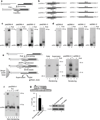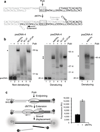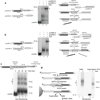Mechanism of microhomology-mediated end-joining promoted by human DNA polymerase θ
- PMID: 25643323
- PMCID: PMC4351179
- DOI: 10.1038/nsmb.2961
Mechanism of microhomology-mediated end-joining promoted by human DNA polymerase θ
Abstract
Microhomology-mediated end-joining (MMEJ) is an error-prone alternative double-strand break-repair pathway that uses sequence microhomology to recombine broken DNA. Although MMEJ has been implicated in cancer development, the mechanism of this pathway is unknown. We demonstrate that purified human DNA polymerase θ (Polθ) performs MMEJ of DNA containing 3' single-strand DNA overhangs with ≥2 bp of homology, including DNA modeled after telomeres, and show that MMEJ is dependent on Polθ in human cells. Our data support a mechanism whereby Polθ facilitates end-joining and microhomology annealing, then uses the opposing overhang as a template in trans to stabilize the DNA synapse. Polθ exhibits a preference for DNA containing a 5'-terminal phosphate, similarly to polymerases involved in nonhomologous end-joining. Finally, we identify a conserved loop domain that is essential for MMEJ and higher-order structures of Polθ that probably promote DNA synapse formation.
Figures







References
METHODS REFERENCES
-
- Gunn A, Stark JM. I-SceI-based assays to examine distinct repair outcomes of mammalian chromosomal double strand breaks. Methods Mol Biol. 2012;920:379–391. - PubMed
-
- Guex N, Peitsch MC. SWISS-MODEL and the Swiss-PdbViewer: an environment for comparative protein modeling. Electrophoresis. 1997;18:2714–2723. - PubMed
-
- DeLano WL. Unraveling hot spots in binding interfaces: progress and challenges. Curr Opin Struct Biol. 2002;12:14–20. - PubMed
Publication types
MeSH terms
Substances
Grants and funding
LinkOut - more resources
Full Text Sources
Other Literature Sources
Molecular Biology Databases

